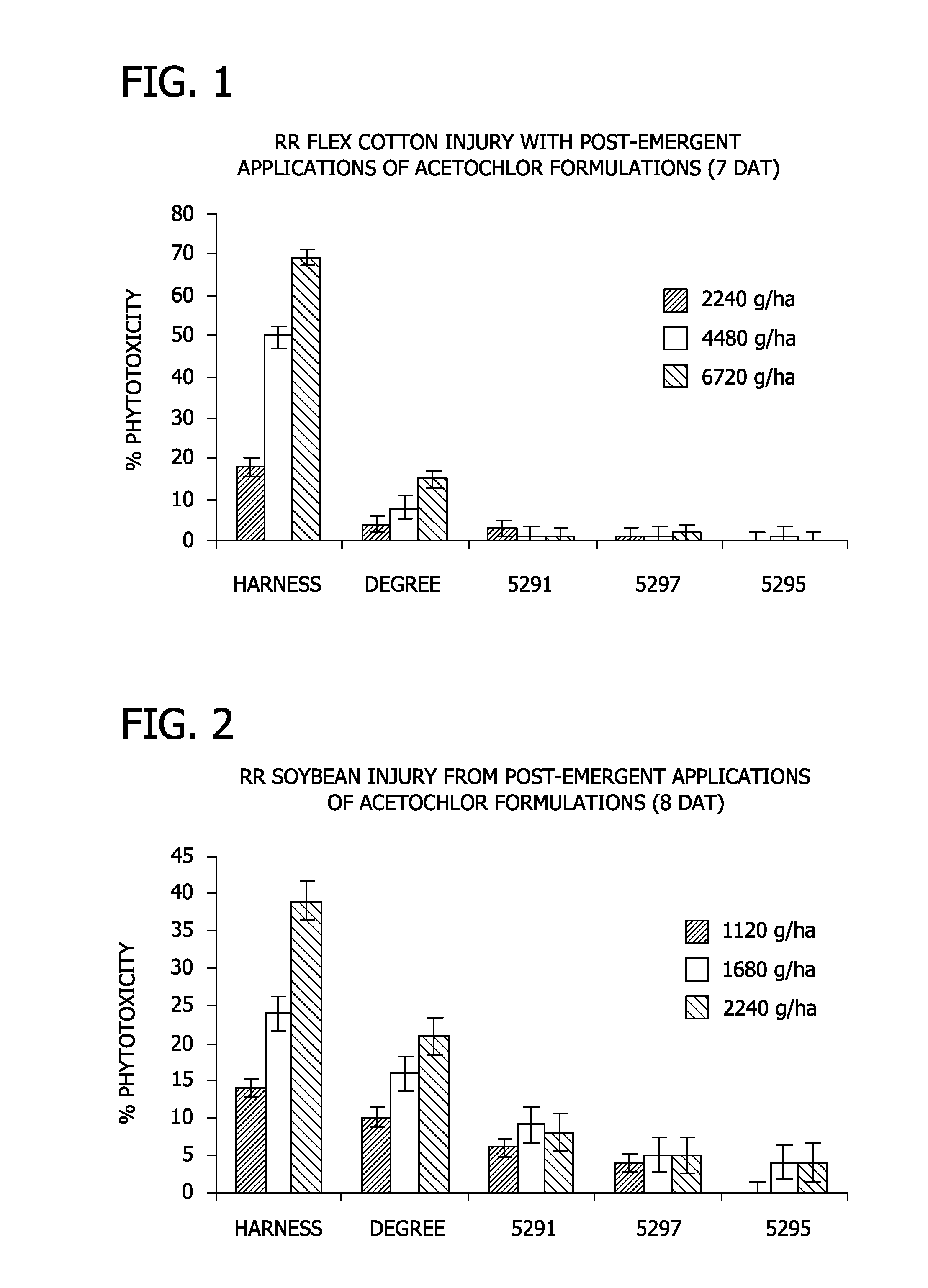Encapsulation of Herbicides to Reduce Crop Injury
a technology of herbicides and herbicide encapsulation, which is applied in the field of herbicide encapsulation to reduce crop injury, can solve the problems of many crops to be damaged or killed, unexpected foliar injury to the crop, and difficulty in optimizing the release rate of practitioners
- Summary
- Abstract
- Description
- Claims
- Application Information
AI Technical Summary
Benefits of technology
Problems solved by technology
Method used
Image
Examples
example 1
Preparation of Aqueous Dispersions of Microencapsulated Acetochlor
[0237]Aqueous dispersions of microencapsulated acetochlor were prepared according to the protocol described in this example. The aqueous dispersions were prepared using a method that resulted in microcapsules having a mean diameter greater than those found in DEGREE, a commercially available microencapsulated herbicidal product containing about 42% by weight acetochlor, available from Monsanto Company. The microcapsules in DEGREE have a mean diameter of about 2.5 μm. The test formulations resulted in aqueous dispersions of microcapsules having mean diameters significantly greater, such as about 5 μm to about 13 μm. Field studies indicated that the aqueous dispersions of herbicidal microcapsules having larger mean diameters exhibited improved crop safety when tested on soybean and cotton compared to DEGREE and also compared to HARNESS, a commercially available herbicidal product containing emulsified concentrate of une...
example 2
Study of Soybean and Cotton Crop Safety and Post-Emergence Weed Control Efficacy Using Microencapsulated Acetochlor Formulations of the Invention
[0250]Formulations 5291, 5297, and 5295 (prepared according to the method described above in Example 1) were applied to glyphosate-tolerant (ROUNDUP READY) soybean and dicamba-tolerant soybeans and glyphosate-tolerant (ROUNDUP READY) cotton (RR Flex—short to mid-season variety) crops under greenhouse conditions. These formulations were tested against commercial acetochlor formulations HARNESS and DEGREE. The formulations were applied to post-emergent soybean and cotton plants and measured for phytotoxicity at 7, 8, and 9 days after treatment (“DAT”). The results are shown in FIG. 1 (Cotton injury 7 DAT), FIG. 2 (Soybean injury at 8 DAT), FIG. 3 (Soybean injury at 9 DAT), and FIG. 4 (Soybean injury at 9 DAT).
[0251]All three experimental formulations provided significantly better crop safety in glyphosate-tolerant (ROUNDUP READY) cotton than ...
example 3
Preparation of Aqueous Dispersions of Microencapsulated Acetochlor
[0255]Three aqueous dispersions of microencapsulated acetochlor (designated formulations 3993, 3995, and 3997) were prepared. All formulations were prepared using the same amine (TETA) and isocyanate (DES N3200), and all formulations contained internal phase solvent, NORPAR 15. The relative ratios of components were held approximately constant. These formulations were prepared using an excess of amine equivalents. The ratios of amine molar equivalents to isocyanate molar equivalents were 1.29:1, 1.26:1, and 1.25:1 in formulations 3993, 3995, and 3997 respectively. The mean particle sizes of each the various formulations were controlled by varying the mixing speed during emulsification.
[0256]Formulations 3993, 3995, and 3997 contained the components shown in the following table:
Form. 3993Form. 3995Form. 3997ComponentWeight of Component (g)Internal PhaseAcetochlor175.0175.0175NORPAR 159.39.39.11DES N320013.0112.8712.79E...
PUM
 Login to View More
Login to View More Abstract
Description
Claims
Application Information
 Login to View More
Login to View More - R&D
- Intellectual Property
- Life Sciences
- Materials
- Tech Scout
- Unparalleled Data Quality
- Higher Quality Content
- 60% Fewer Hallucinations
Browse by: Latest US Patents, China's latest patents, Technical Efficacy Thesaurus, Application Domain, Technology Topic, Popular Technical Reports.
© 2025 PatSnap. All rights reserved.Legal|Privacy policy|Modern Slavery Act Transparency Statement|Sitemap|About US| Contact US: help@patsnap.com



